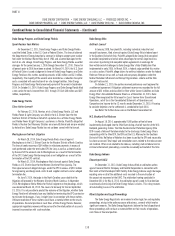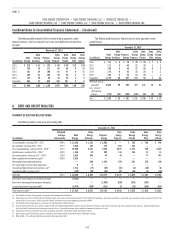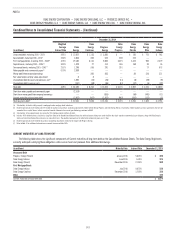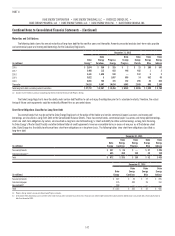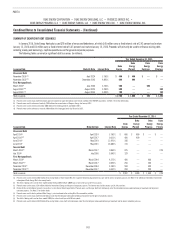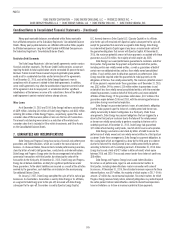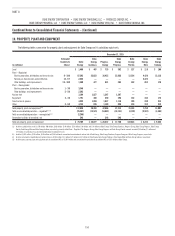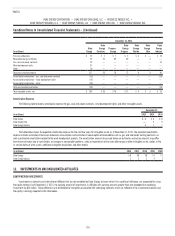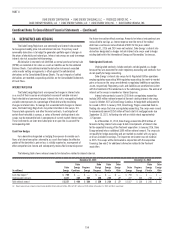Duke Energy 2015 Annual Report Download - page 167
Download and view the complete annual report
Please find page 167 of the 2015 Duke Energy annual report below. You can navigate through the pages in the report by either clicking on the pages listed below, or by using the keyword search tool below to find specific information within the annual report.
147
PART II
DUKE ENERGY CORPORATION • DUKE ENERGY CAROLINAS, LLC • PROGRESS ENERGY, INC. •
DUKE ENERGY PROGRESS, LLC • DUKE ENERGY FLORIDA, LLC • DUKE ENERGY OHIO, INC. • DUKE ENERGY INDIANA, INC.
Combined Notes to Consolidated Financial Statements – (Continued)
9. ASSET RETIREMENT OBLIGATIONS
Duke Energy records an asset retirement obligation (ARO) when it has
a legal obligation to incur retirement costs associated with the retirement of a
long-lived asset and the obligation can be reasonably estimated. Certain assets
of the Duke Energy Registrants’ have an indeterminate life, such as transmission
and distribution facilities, and thus the fair value of the retirement obligation is
not reasonably estimable. A liability for these asset retirement obligations will be
recorded when a fair value is determinable.
The Duke Energy Registrants’ regulated operations accrue costs of
removal for property that does not have an associated legal retirement obligation
based on regulatory orders from state commissions. These costs of removal
are recorded as a regulatory liability in accordance with regulatory accounting
treatment. The Duke Energy Registrants do not accrue the estimated cost of
removal for any nonregulated assets. See Note 4 for the estimated cost of
removal for assets without an associated legal retirement obligation, which are
included in Regulatory liabilities on the Consolidated Balance Sheets.
The following table presents the AROs recorded on the Consolidated Balance Sheets.
December 31, 2015
(in millions)
Duke
Energy
Duke
Energy
Carolinas
Progress
Energy
Duke
Energy
Progress
Duke
Energy
Florida
Duke
Energy
Ohio
Duke
Energy
Indiana
Decommissioning of Nuclear Power Facilities $ 5,072 $ 1,730 $ 3,093 $ 2,349 $ 744 $ — $ —
Closure of Ash Impoundments 4,958 2,161 2,196 2,188 7 94 507
Other(a) 234 27 80 30 51 31 18
Total Asset retirement obligation $ 10,264 $ 3,918 $ 5,369 $ 4,567 $ 802 $ 125 $ 525
(a) Includes obligations related to asbestos removal and the closure of certain landfills at fossil generation facilities. Duke Energy Ohio also includes AROs related to the retirement of natural gas mains. Duke Energy also includes
AROs related to the removal of renewable energy generation assets.
North Carolina and South Carolina Ash Impoundments
On September 20, 2014, the Coal Ash Act became law and was amended
on June 24, 2015, by the Mountain Energy Act. The Coal Ash Act, as amended,
(i) establishes a Coal Ash Management Commission (Coal Ash Commission) to
oversee handling of coal ash within the state; (ii) prohibits construction of new
and expansion of existing ash impoundments and use of existing impoundments
at retired facilities; (iii) requires closure of ash impoundments at Duke Energy
Progress’ Asheville and Sutton plants and Duke Energy Carolinas’ Riverbend
and Dan River stations no later than August 1, 2019 (the Mountain Energy Act
provides for the potential extension of closure of the Asheville impoundment
until 2022); (iv) requires dry disposal of fly ash at active plants, excluding the
Asheville Plant, not retired by December 31, 2018; (v) requires dry disposal
of bottom ash at active plants, excluding the Asheville Plant, by December
31, 2019, or retirement of active plants; (vi) requires all remaining ash
impoundments in North Carolina to be categorized as high-risk, intermediate-risk
or low-risk no later than December 31, 2015, by the NCDEQ with the method of
closure and timing to be based upon the assigned risk, with closure no later than
December 31, 2029; (vii) establishes requirements to deal with groundwater
and surface water impacts from impoundments; and (viii) increases the level of
regulation for structural fills utilizing coal ash.
In January 2016, NCDEQ published its draft risk classifications. These risk
rankings were generally determined based on three primary criteria: structural
integrity of the impoundments and impact to both surface and groundwaters.
NCDEQ categorized 12 basins at four sites as intermediate risk and four basins
at three plants as low risk. NCDEQ also categorized nine basins at six plants as
“low-to-intermediate” risk, thereby not assigning a proposed risk ranking at this
time. The risk rankings of these sites will be based upon receipt of additional
data primarily related to groundwater quality and the completion of specific
modifications and repairs to the impoundments. NCDEQ is expected to finalize
its risk classifications as part of a public comment process. Duke Energy cannot
predict the final classification.
The Coal Ash Act includes a variance procedure for compliance deadlines
and modification of requirements regarding structural fills and compliance
boundaries. Provisions of the Coal Ash Act prohibit cost recovery in customer
rates for unlawful discharge of ash impoundment waters occurring after January
1, 2014. The Coal Ash Act leaves the decision on cost recovery determinations
related to closure of ash impoundments to the normal ratemaking processes
before utility regulatory commissions. Duke Energy has and will periodically
submit to NCDEQ site-specific coal ash impoundment closure plans or
excavation plans in advance of closure. These plans and all associated permits
must be approved by NCDEQ before any excavation or closure work can begin.
In September 2014, Duke Energy Carolinas executed a consent agreement
with the South Carolina Department of Health and Environmental Control
(SCDHEC) requiring the excavation of an inactive ash basin and ash fill area
at the W.S. Lee Steam Station. As part of this agreement, in December 2014,
Duke Energy Carolinas filed an ash removal plan and schedule with SCDHEC. In
April 2015, the federal Coal Combustion Residuals (CCR) rules were published
and Duke Energy Carolinas subsequently executed an agreement with the
conservation groups Upstate Forever and Save Our Saluda that requires Duke
Energy Carolinas to remediate all active and inactive ash storage areas at
the W.S. Lee Steam Station. Coal-fired generation at W.S. Lee ceased in 2014
and unit 3 was converted to natural gas in March 2015. In July 2015, Duke
Energy Progress executed a consent agreement with the SCDHEC requiring the
excavation of an inactive ash fill area at the Robinson Plant within eight years.
Coal ash impoundments at the Robinson Plant and W.S. Lee Station sites are
required to be closed pursuant to the recently issued CCR rule and the provisions
of these consent agreements are consistent with the federal CCR closure
requirements.
Coal Combustion Residuals
On April 17, 2015, the EPA published in the Federal Register a rule
to regulate the disposal of CCR from electric utilities as solid waste. The
federal regulation, which became effective in October 2015, classifies CCR as
nonhazardous waste under Subtitle D of the Resource Conservation and Recovery
Act and allows for beneficial use of CCR with some restrictions. The regulation
applies to all new and existing landfills, new and existing surface impoundments
receiving CCR and existing surface impoundments that are no longer receiving CCR
but contain liquid located at stations currently generating electricity (regardless



